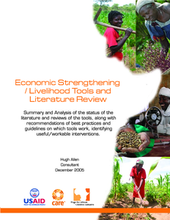Orphans and Vulnerable Children (OVC) and families affected by HIV/AIDS are especially vulnerable to economic collapse and destitution as their income and asset base gets eroded by the progression of the disease. It becomes especially urgent to develop strategies and products that reduce this vulnerability before it tips the family into destitution, when assets are sold and the capacity to generate income is eliminated. Economic strengthening through microenterprise becomes a critical part of the process and involves a range of financial and business development services.
Microfinance (savings, insurance and credit) services are critical because they provide clients with access to useful lump sums at times when they are needed, through savings, through loans and, in special emergencies, through insurance. In recent years microfinance organisations and banks have become much more responsive to customer needs and have developed a broader range of products that are inherently more flexible than the old credit-only solidarity group models. At the same time, this increase in product variety and flexibility has benefited HIV/AIDS affected people, but there is now particular attention to the strategies, products and methodologies that take cognisance of the effects of disease, both on clients and the institutions themselves. The most common strategies/product adaptations are:
• Loans with flexible terms
• Short-term emergency loans
• Insurance: credit, life, health and funeral
• Reduced emphasis on compulsory savings products and allowing voluntary withdrawal and/or emergency liquidation of a compulsory balance
• Reduce or limit the level of mutual guarantee required to access a loan
• Formation of ASCAs
• Contractual savings for predictable costs (i.e. school fees)
• Incorporating HIV/AIDS education and cultivating links to ASOs
• Loans to youths and orphans
Increasingly, however, it is recognised that microfinance as a whole is unable to reach a large proportion of the population that lives in remote rural areas or constitute the very poor in urban areas. Emerging experience with a raft of international and southern NGOs is showing that ASCAs are able to extend outreach significantly, reaching affected populations that MFIs and banks are unable to serve and, through their user friendly and highly flexible modes of operation, able to offer services (admittedly on a small per-person scale) that are extremely well adapted to the needs of the very poor for savings, insurance and self-financing credit services. In terms of Business Development Services (BDS), the paper looks at new and emerging practice that is specifically adapted to the needs of HIV/AIDS affected people and OVC.
One of the most promising developments relates to large-scale market-based initiatives that seek to deliver low-cost, high-quality mass-manufactured technologies that contribute to increases in productivity, reduced demand for labour and significant value added. This fits well with the need for HIV/AIDS affected families to increase or maintain income with a reduced labour capacity.
In recognizing that most HIV/AIDS affected people are those who operate income generating activities that seek to maximise business drawings and minimize reinvestment, most standard business training manuals and approaches are not appropriate. Work done on developing training manuals focused specifically on OVC and HIV/AIDS affected individuals has proven itself to be relevant and cost effective is highlighted.
©Hope for African Children Initiative

